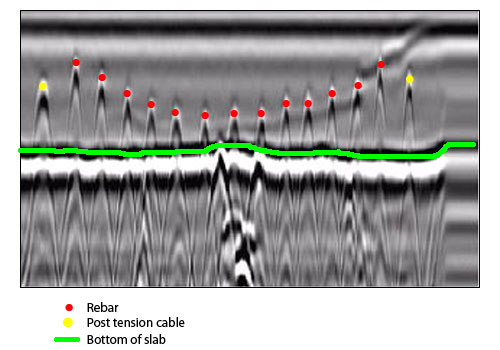Trick Benefits of Making Use Of Concrete Scanning Technology
Wiki Article
Introduce the Transformative Power of Concrete Scanning in Optimizing Effectiveness and Security
Concrete scanning has become an important device in the construction sector, supplying unequaled benefits in enhancing job effectiveness and making sure safety requirements. By utilizing innovative modern technology, concrete scanning allows specialists to see past the surface area, revealing surprise intricacies that could impact the structural stability of a building. The transformative power of concrete scanning depends on its capability to offer detailed insights and real-time data, changing exactly how tasks are planned and carried out. As we look into the complexities of this ingenious strategy, a globe of possibilities opens up, showcasing a brand-new age of building and construction practices that focus on accuracy and safety.Value of Concrete Scanning
Making sure the structural integrity and safety of building projects starts with the important step of performing detailed concrete scanning. Concrete scanning is a non-destructive approach made use of to spot and map subsurface elements within concrete structures.In addition, concrete scanning aids in optimizing task timelines and spending plan by preventing unforeseen prices and hold-ups that might occur due to unpredicted obstructions within the concrete. Inevitably, spending in extensive concrete scanning is a proactive approach that enhances both efficiency and safety and security in building and construction jobs.
Just How Concrete Scanning Functions
Concrete scanning runs as an important tool in building tasks by using advanced technologies to identify and map subsurface components without causing architectural damage. Ground Passing Through Radar (GPR) and Electromagnetic Induction (EMI) are two main methods used in concrete scanning.During the scanning procedure, the data accumulated is examined in real-time, allowing instant recognition of potential threats or obstacles beneath the surface. This details help in decision-making, ensuring that building activities proceed securely and efficiently. Furthermore, 3D imaging software can be utilized to produce detailed maps of the subsurface components, further boosting project preparation and execution. By utilizing these sophisticated technologies, concrete scanning significantly lowers the danger of pricey damages and injuries on construction websites.
Benefits of Concrete Scanning
Making use of advanced scanning innovations in building tasks uses a plethora of benefits, improving both effectiveness and safety and security on-site. One of the primary benefits of concrete scanning is the ability to identify and locate embedded things such as rebar, post-tension cable televisions, and avenues properly. By recognizing these elements before exploration or cutting into concrete structures, the danger of unintentional strikes is considerably minimized, stopping potential injuries to workers and damages to the structure itself. Concrete scanning helps in preparation and creating extra properly, as it gives precise information about the area and depth of structural components.
Study: Concrete Scanning Success

In one more instance, a building and construction business used 3D concrete scanning to analyze the problem of aging concrete frameworks in a historic structure. The comprehensive scans offered useful insights into the degree of damage and assisted prioritize maintenance efforts successfully. By proactively addressing locations of worry recognized with scanning, the business had the ability to expand the lifespan of the structure and make sure passenger safety.
These situation research studies highlight the transformative power of concrete scanning in improving effectiveness, precision, and safety in building tasks.
Implementing Concrete Scanning in Projects
Implementing sophisticated scanning innovations during building tasks has actually come to be significantly vital for enhancing precision and safety. By integrating concrete scanning into job planning and execution, building groups can determine prospective threats, such as rebar or post-tension cords, concealed within concrete frameworks. This aggressive approach decreases the danger of mishaps, delays, and costly rework, eventually causing extra effective project timelines and budgets.To execute concrete scanning efficiently, project supervisors should collaborate closely with skilled scanning experts to identify one of the most suitable scanning methods for the particular project requirements. Engaging scanning professionals from the beginning of a task enables the team to create extensive scanning strategies that resolve essential areas of issue and make sure complete information collection.
Additionally, including concrete scanning into normal task workflows can streamline decision-making processes, as real-time scan information gives prompt insights right into the condition of concrete frameworks - Concrete Scanning. This data-driven strategy promotes educated analytic and allows teams to click reference make changes quickly, promoting a society of performance and safety throughout the project lifecycle

Verdict
To conclude, concrete scanning plays an important function in boosting performance and security in building tasks. By using innovative modern technology to map and identify out underlying structures within concrete, this process helps to stop expensive mistakes, make sure structural integrity, and decrease risks on site. With the ability to discover covert aspects and supply accurate data, concrete scanning shows to be an important tool for optimizing job results and making best use of total success.Concrete scanning is a non-destructive method used to find click this link and map subsurface aspects within concrete structures. In addition, concrete scanning helps in enhancing task timelines and spending plan by preventing unanticipated expenses and delays that might emerge due to unanticipated obstructions within the concrete. One remarkable situation study includes a massive improvement job where concrete scanning played a crucial role in making sure task success.In another situation, a building business utilized 3D concrete scanning to analyze the condition of maturing concrete structures in a historic building. By incorporating concrete scanning into task preparation and implementation, building groups can recognize possible risks, such as rebar or post-tension cords, concealed within concrete frameworks.
Report this wiki page